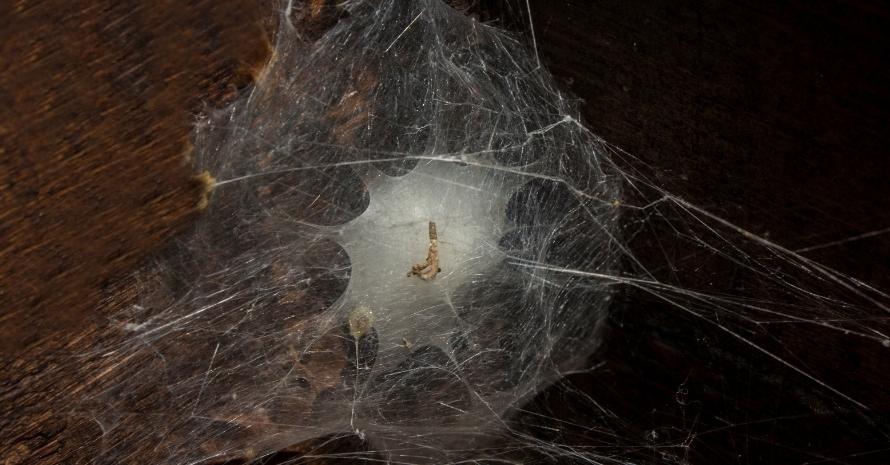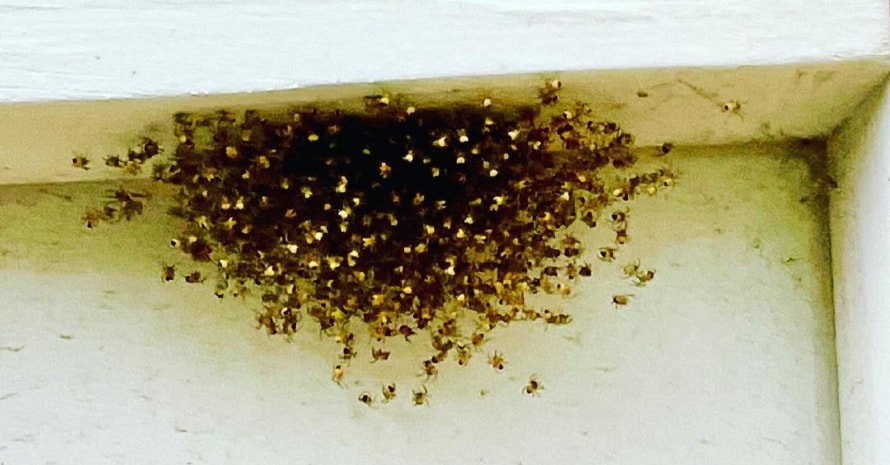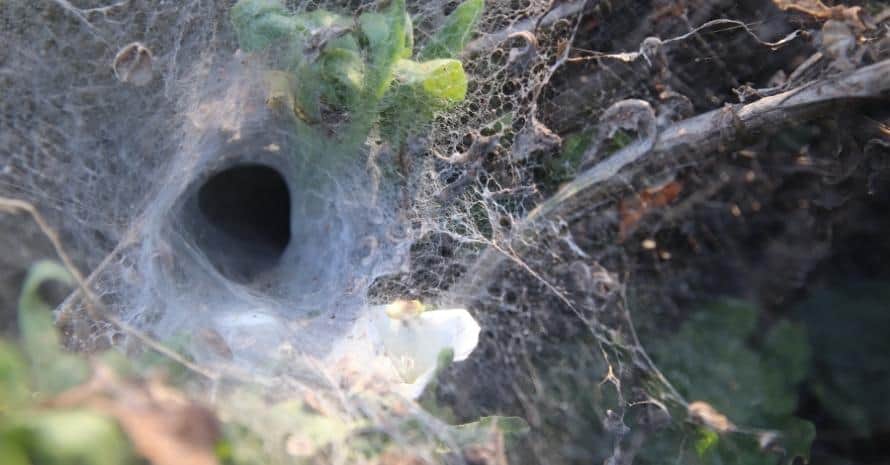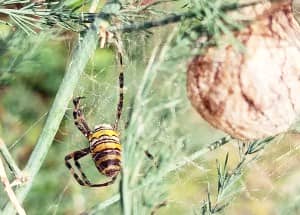Spider nests contain the future generations of a species, including all adult spiders. In the dark, hidden regions of your home, such as the nooks and crannies of walls and ceilings, certain species of spiders may construct tiny silken nests or sacs. If you have seen this, you need to take immediate action, or the spider population will continue to expand.
How to get rid of a spider nest? Please read on if you are curious about eliminating it. This guide will aid you in eliminating those annoying spiders and stopping their potential to procreate.
[wpsm_titlebox title=”How to Get Rid of a Spider Nest?” style=”main”]
- Spray the nest with pesticides or bleach and water mixture.
- After thoroughly soaking the nest, vacuum it or brush it down with a feather duster, broom, or another cleaning tool.
- Spray the area and any other sites likely to be infested by spiders with a preventative pesticide.
[/wpsm_titlebox]
What You Need to Know About Spider Nest
If you haven’t seen a lot of spiders in your home but found something similar to their webs, you better start taking some actions to prevent your home from being full of them. How many babies do house spiders have? The female produces approximately 250 eggs, and they will hatch after 7–10 days, which is a lot. So, here’s some useful information to avoid a bunch of spiders in your home.
What are spider’s nests?
Spider webs, spider eggs, and newly hatched spiderlings are the components of a spider nest. It thrives in the shade, secluded spots where it is shielded from the elements. Keep in mind that spider webs are resilient and adaptable.
The size of these spider homes varies widely across different species. Cobweb spiders are the most frequent variety; they spin massive webs near doors and windows to catch prey such as flies and mosquitoes. Their nests aren’t dangerous, but they may get ugly fast if you let them go unattended.

In most cases, the spider eggs in a nest will be guarded by a queen spider. Careless removal of these nests might provoke a spider assault, resulting in serious injury. If you come upon a nest of spiders in the house, you should proceed with extreme caution.
What do they look like?
There’s more to a spider nest than meets the eye when you see a web stretched up in the corner of your home. The number of spiders living in a nest determines how big the nest gets. The strings leading to the middle, where the spider eggs and baby spiders are, give the impression of a big ball of webbing.
Certain spider nests can produce an exterior layer that resembles silk but is coarser than the ordinary webs you may find in your garden or on your porch.
It’s important to get rid of a spider nest as soon as possible before the spiders can populate a large area.
What does a spider nest look like? Spider nests can look different depending on what type of spider spun the web. There are 5 main types of spider webs/nests:
- Spiral orbs;
- Tangle (sometimes referred to as “cobweb” nests);
- Sheet webs;
- Tubular;
- Funnel.
How to find a spider’s nest?
Nests of spiders aren’t very difficult to locate. If you detect cobwebs in a dark corner or place, such as under the stairs or behind some furniture, chances are good that you’ve found a spider nest there.
Search for spiderwebs. If you find one or more little ones, check the nearby regions. The nest can be located if you see a larger, more intricate web that contains egg sacs. Look for huge balls of webbing near windows and doors; just make sure it doesn’t contain any spider eggs before eliminating it.
Step-by-step instructions: How to kill a spider nest?

It’s not hard to eliminate spiders and their webs. Typically, a broom or feather duster is used to knock them down. The spiders and their egg sacs can survive even if the webs are destroyed. In addition, the egg sac may burst if you knock over the nest, releasing hundreds of baby spiders into your home. So, how to kill a spider nest?
Step 1: Spray the nest with pesticides or bleach and water mixture
Use insecticides or a bleach and water combination to spray the nest. Both are effective. However, research shows that oil-based pesticides are more successful at killing off the pests’ egg sacs.
Spraying the nest with a solution of bleach and water is another option. Use as much of the solution as directed, and thoroughly soak the nest before attempting to remove it.
Step 2: Take down the nest
Once the nest has been drenched, you may dispose of it. It may be cleaned by vacuuming or brushing with a feather duster, broom, or other equipment. If you choose to vacuum it, remember to empty the canister or bag right after you’re done. You don’t want spider eggs to hatch in your vacuum if the spray didn’t kill them all.
Step 3: Spray preventative pesticides
The third step is to use a prophylactic pesticide to treat the area and any additional potential spider nesting spots. Always read the labels to make sure the pesticide is safe for removing spiders, the specific species in question, and the planned application site. You should reapply it as directed.
Space sprays containing pyrethrin or pyrethroids can kill spiders they come into contact with but have a little lasting impact. Thus, it’s important to get as close to the spiders and their webs as possible while applying the chemical. When the spider eggs hatch, which usually takes around 4 weeks, you’ll need to spray again.
Cracks and crevices can be treated with a thin layer of an aerosol or liquid pesticide. Vacant spaces, like those where spiders like to hide, are ideal places to use pesticide dust for control. When dust lands on a web, the spiders that live there will consume it and use the protein in the silk to grow their population.
A natural way to kill spiders inside a house is to use a combination of 50% bleach and 50% water to spray on spider eggs and baby spiders. Spiderlings can run quite quickly, but their delicate exoskeletons won’t survive a soak in bleach.
Preventing spider nest reestablishment

Prevention is a crucial part of getting rid of spider nests. Here is what you need to do:
- Once you’ve eliminated the spider infestation by destroying its nests, it’s important to take precautions to ensure that the spiders don’t return. The best way to prevent spiders from setting their nests in your house is to make it unpleasant to them.
- Put away all the logs and firewood and keep them away from your house.
- To lessen the number of hiding places in your home, you should get rid of any unnecessary stacks of papers, newspapers, cardboard boxes, bags, etc.
- Cracks and openings in the house’s construction should be caulked or sealed if they exist, particularly around the house’s foundation, windows, and doors. Caulk any gaps you find in the basement or the foundation.
- Doors and windows should fit snugly in their frames, the screening should be in good condition, and the bottoms of doors should have sweeps fitted.
- High-pressure sodium vapor or halogen lighting should be used to replace incandescent bulbs if spiders are a persistent problem in your home. Keep the lights off at night or install them to highlight the entrance area, but not the room around it, as insects are drawn to light.
- Apply a prophylactic spray around the house’s perimeter, and anywhere you’ve found spider egg sacs to deter spiders from moving in.
FAQ
Here are some common questions from people struggling with spiders and their nests. Check them out! They may also be useful for you.
Where do spiders nest in houses?
Spiders typically choose quiet, dark corners of the house to set up their webs. When nesting inside, they prefer to do it in cool, dark places like the basement, garage, or attic. They often construct their nests in cluttered attics or other concealed locations.
Can spiders get out of a vacuum?
Spiders that are inadvertently sucked into a vacuum won’t be able to escape. Every single spider pulled into a household vacuum cleaner dies, either instantly from the trauma of being swept into the machine’s tight tubes or later on from dehydration.
What kills baby spiders?
A combination of bleach and water makes an excellent spray. This common home product is so lethal to insects and spiders that they die in a few minutes. Spider eggs are easily swept or vacuumed away because of their fragility.
Just Get Rid of It
Finding a huge spider nest full of egg sacs within your house might be upsetting, but fortunately, these nests can be easily removed. It is possible to eliminate or remove the nest while preserving the egg sacs and spiders. The most crucial step is locating the spider’s nest so that you may take the appropriate measure. Afterward, getting rid of it is easy.
Try this method, and let me know if it works for you. Also, I would like you to leave your comment if you have other effective approaches for getting rid of spider nests.
Also read:
- How to Get Rid of Clover Mites: Best Ideas
- How to Get Rid of Spider Mites for Beginners
- How to Get Rid of Mites: Complete Ticks Control
- How to Get Rid of Chicken Mites on Humans: Complete Control & Prevention Guide
- How to Get Rid of Red Mites: Complete Red Mites Control & Prevention Guide
References:
- Spiders (Darlington)
https://www.darlington.gov.uk/environmental-health/pest-control/spiders/ - Common house spider (Missouri department of conservation)
https://education.mdc.mo.gov/discover-nature/field-guide/common-house-spider - Efficacy of Several Pesticide Products on Brown Widow Spider (Araneae: Theridiidae) Egg Sacs and TheirPenetration Through the Egg Sac Silk (Household and Structural Insects)
https://ucanr.edu/sites/ucrurbanpest/files/232647.pdf

